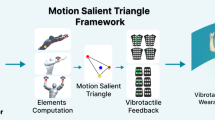Abstract
Virtual reality (VR) technology has become more and more mature over the last decade. Development of a virtual environment for training purpose is considered to be one of the most practical applications of the VR technology. Since the VR technology involves all kinds of sensors in exchanging information between the real world and the virtual environment, it is computationally intensive in terms of data processing at an individual sensor and information integration among all the sensors. In general, the information integration has to be well synchronized in order to meet the training needs. At the same time, real-time processing capability is also considered to be critical. Many more practical issues could be uncovered only when a virtual training environment is actually being developed. Based on this belief, this study experiments on the development of a virtual environment for training billiards players. The technical difficulties encountered and the corresponding resolutions are considered beneficial to the development of other practical virtual training environments. This paper summarizes the design and implementation details about our experimental virtual training environment for edutainment systems such as virtual billiard game, virtual air hockey game and virtual drum performance with the algorithms for the synchronization of the information from different sources.




















Similar content being viewed by others
References
Dragovi’c V, Radnovi’c M (2006) Geometry of integrable billiards and pencils of quadrics. J Math Pures Appl 758–790
Jebara T, Eyster C, Weaver J, Starner T, Pentland A (1997) Stochasticks: augmenting the billiards experience with probabilistic vision and wearable computers. Proc Int Symp Wearable Comput 138–145
Matsuura H, Abe N, Tanaka K, Taki H, He S (2006) Virtual air hockey game allowing two players to fight thorough network. J Comput Inf Syst 583–591
Pan Y, Abe N, Tanaka K, Taki H (2004) The virtual debugging system for developing embedded software using virtual machinery. In: Proceedings of embedded and ubiquitous computing, international conference (EUC 2004), pp 85–95, Aizu, Japan
Takamura Y, Abe N, Tanaka K, Taki H, He S (2006) A virtual billiard game with visual auditory and haptic sensation. Lecture notes in artificial intelligence 1609, Foundations of Intelligent Systems, pp 700–705
Tanaka K, Kaida M, Abe N, Taki H (2002) Synchronization of visual, haptic and auditory sense using a haptic display and a virtual sound source device. In: International society on virtual systems and multimedia (VSMM), pp 673–680
Watanabe Y, Abe N, Tanaka K, Taki H, Yagi T (2005a) Multimodal communication system allowing man and avatar to use voice and beck. In: 3rd International conference on information technology and applications (ICITA’2005), pp 161–166
Watanabe Y, Tokumochi D, Abe N, Tanaka K, Taki H, Kinoshita Y (2005b) Cutting virtual organ model with haptic feedback device. The first international conference on complex medical engineering—CME2005, pp 255–260
Author information
Authors and Affiliations
Corresponding author
Rights and permissions
About this article
Cite this article
Tabuchi, Y., Abe, N., Taki, H. et al. Synchronization between audiovisual and haptic feeling for constructing edutainment systems. Virtual Reality 12, 27–36 (2008). https://doi.org/10.1007/s10055-008-0085-y
Received:
Accepted:
Published:
Issue Date:
DOI: https://doi.org/10.1007/s10055-008-0085-y



